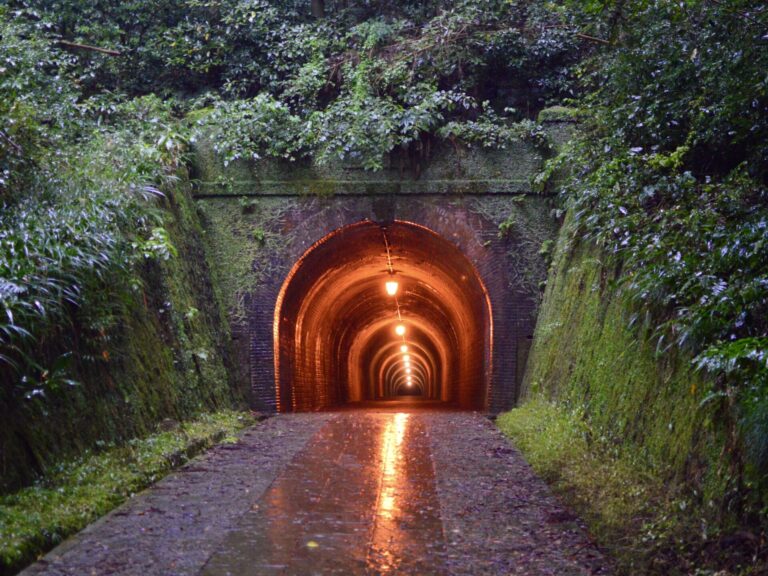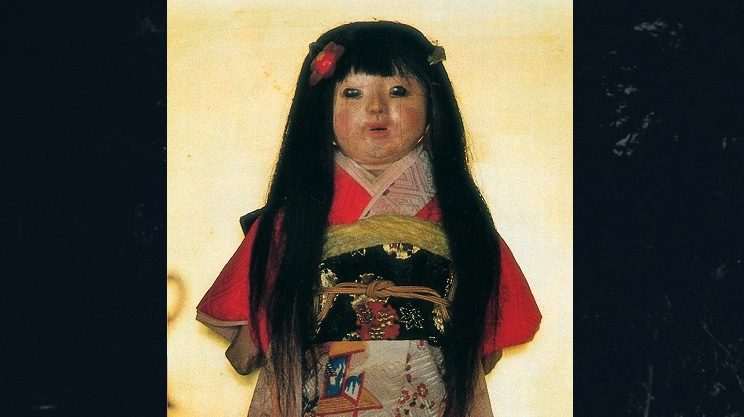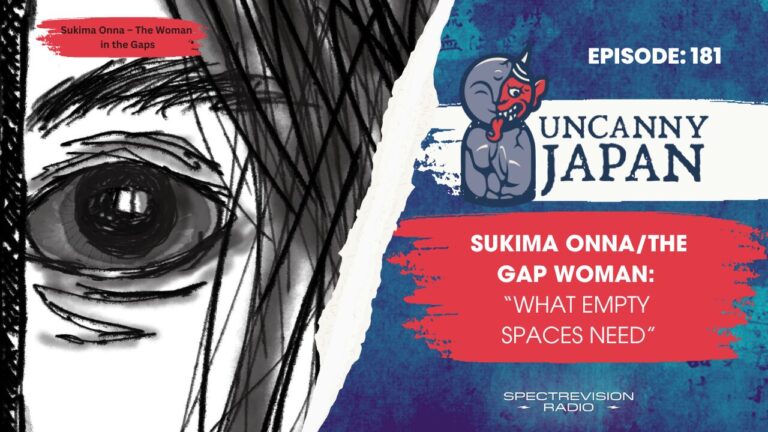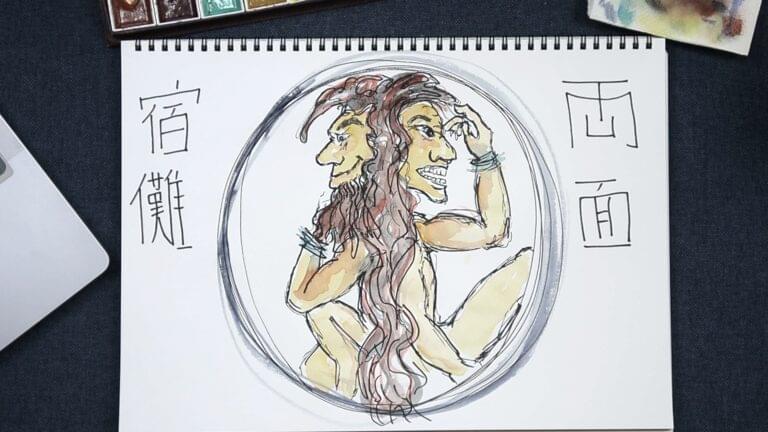Let’s visit some local haunted areas or shinrei supotto in Japanese. The Suicide Forest, a very haunted tunnel, and a Severed Head Grave are all in today’s show.
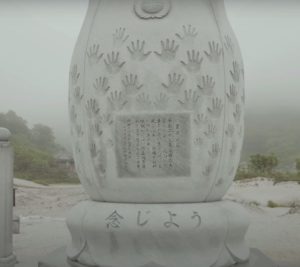
Shinrei Supotto
On today’s show let’s visit a few ghostly places. They’re called shinrei supotto in Japanese. Areas that are believed to be haunted or cursed or have some other paranormal activity going on.
But first a warning, actually, two warnings.
First Warning
Number one is from my mother-in-law. It’s a true story that she used to tell me when she was trying to stop me from doing something she thought was stupid or dangerous.
It goes like this: Many years before I came to Japan there was a relative, a young man, in his twenties, who was bright and cheerful and outgoing. But he was also very curious about otherworldly things. One day he decided to go to Osorezan, a place way up north, in Aomori Prefecture. Osorezan is also known for its itako, or mediums. These elderly, blind women are thought to be able to communicate with both Shinto gods and the dead. Osorezan – the name meaning Dreadful Mountain – is also believed be one of the gateways to the hell.
See, I had heard about this place, seen some cool photos and expressed great interest in going there, and that’s what spurred my mother-in-law’s warning tale.
So, she says, this happy-go-lucky relative also made the trip there, alone, with the same nonchalant attitude I had. It seems he visited one of the itako, did some stuff, stayed the night at a temple, then came home. But no one knows for sure exactly what he did there, or what happened, because after he returned he was different. There was something very off about him. He was no longer the carefree, bright person he had been before.
Everyone had opinions about what had happened up north. The consensus being that because he visited the area with such an irreverent attitude he attracted some spiteful spirit and it had attached itself to him. He’d seen doctors and gone through oharai, that cleansing ritual I mentioned in the last episode, but nothing helped. I personally never met this relative. My mother-in-law said they preferred to keep him at home and away from others.
Now that’s a story that will put the fear of god in you. Better yet, the fear of ghosts in you. That tale along with others and her extreme caution with all mysterious phenomena have always stuck with me. Don’t go lightly into things you don’t understand.
But it is near Halloween and we do need some escape from the horror that is the real world, so I do want to take you, vicariously, to a few famous and not-so-famous haunted spots near me.
So go and turn off the lights, light a candle or two, and get comfy on the couch. Tonight we’re going to visit some ghosts.
Second Warning
Remember I said there were two warnings? That second one. I guess it’s not so much a warning but more of a suggestion, a cultural thing if you will. Which I’ll preface with the fact that every single Uncanny Japan listener I’ve ever interacted with has been beyond smart, considerate and respectful of the Japanese culture. So this isn’t about you. I just feel I need to say it.
Several years ago some Youtuber barged into Japan with his lights and cameras and took his film crew into Aokigahara (青木ヶ原) , also called Jukai (樹海) or Sea of Trees; but you might have heard of its other name: The Suicide Forest. This, I-still-have-no-idea-why-he’s-famous-person indeed ran across someone who had committed suicide and for whatever reason thought it was a good idea to post the video on Youtube. Horrific, right?
Deep down, even though I’ve lived here thirty plus years, I don’t feel comfortable looking up haunted areas and heading there with my camera and microphones at midnight to see what happens. It feels a little crass and disrespectful, if you know what I mean.
And yeah, also, a little bit, my mother-in-law’s story and the fact that she swore up and down that I was sticky and ghosts liked hanging around me naturally, and I don’t want to test the theory that a disgruntled Japanese spirit or two might decide to follow me home and make the rest of my life a living hell.
So today you and I will be visiting those shinrei supotto, ghost spots. But they’ll will be ones I’ve heard and read a lot about or I have been to myself but totally by accident. Like it’s not uncommon in Japan to visit some scenic spot and while there someone leans over and says, “Hey, see right there? That is where those two lovers held hands, leap from the cliff and plunged into the rocky sea. If you come here at night you can still hear them scream.”
What?
Anyway, there are so many haunted spots in Japan I almost don’t know where to begin. So in order to narrow things down, I’m going to stick to areas near me. So let’s get started at a place that I think has become quite well known of late. The one I just mentioned:
Aokigahara or jukai or the Suicide Forest
This is 30-square kilometers or 12-square miles of forest at the foot of Mount Fuji. It’s a very interesting forest, grown up over the lava flow from Mount Fuji’s last eruption. It’s incredibly bumpy and mossy, with ice caves and wind caves, and some parts very dense and disorienting. There used to be a saying that once you stepped into the jukai, sea of trees, you wouldn’t make it out alive.
There are a lot of myths about not being able to use a compass or electronic devices going haywire once inside. This isn’t exactly true. But there is the presence of magnetic iron in the ground which some say can mess with devices. Or, I don’t know, it could be all the ghosts. There are lots of tales of people being led off the main path by devious spirits.
The forest is haunted not just by the poor souls who ended their lives there, but the jukai, sea of trees, is supposedly also a well known area for ubasute, remember when we talked about ubasute yama? Impoverished families carrying their very elderly up a mountain because they couldn’t afford to care for them anymore. Well, that was believed to happen here as well.
Now I’ve been to Aokigahara numerous times without even knowing it. I live about an hour and a half from Mount Fuji and you have to drive through the Sea of Trees to get there. So for years I was passing through the forest without knowing anything about legends.
I do distinctly remember, though, that the whole area felt weird, heavy and really, really quiet. I just recently learned that the porous lava rock ground absorbs sound giving it this quality. Also, I remember when we had stopped to rest and look around, the signs, usually very old and worn, that encouraged people to think again, consider the life their parents had given them, and contact a suicide prevention number at the bottom.
I’ve heard people also go there to nail waraningyo to trees. Remember I talked about them in episode 52, those straw dolls used to curse your enemies.
Oh, and while I never went very far into the forest, I remember seeing the colored ribbons. In order not to get lost, which is easy to do if you go off the paths, people tie ribbons or tape to something and wind their way through the trees. I watched a video with a Japanese man who often goes into the forest. He said nothing good is ever found at the end of one of those ribbons. Ghosts?
Baba Ana or the the Grannie or Old Auntie Cave
So we were just talking about ubasute yama, throwing away grannies on a mountain. And, well, there’s throwing away grannies in a forest, too. Next, let me introduce you to throwing away grannies in a hole in the ground.
I just learned about this one, but it came up a lot when I was searching for famous spots in my prefecture. It’s a people-sized hole in a forest that is about 20 meters deep. It’s said here is where, again the elderly or infirm were thrown occasionally. Once you fall in, you can’t get out evidently.
And also, that human bones have been found at the bottom of the hole. At night, if you go near it, you might see a hand reaching out. But don’t get too close, because there are stories of reckless types getting pulled into the hole never to be seen again.
Tunnels
About 73% of Japan is mountainous that naturally means there are a lot of tunnels. And invariably bad things happen in tunnels, collapses, fires, car crashes. Even locally it feels like so many tunnels have ghost stories attached to them. Especially the older ones that are narrow, long, and drippy and have have little or no illumination.
Let’s talk about the old Amagi Tunnel in Izu. It was completed in 1905 and being built completely of stone it’s the longest remaining all-stone tunnel in Japan at 446 meters, over 13,000 feet long. It’s surrounded by a dense forest which adds to the feeling of isolation. It’s also narrow and dark and damp. There are thought to be a lot of ghosts and onryou in and around it.
The Old Amagi Tunnel has a creepy atmosphere about it especially at night. And because of weird atmospheric pressure the wind blows or is sucked through the tunnel making strange noises. While deep inside the tunnel sometimes you can hear a woman singing or whispering or asking, Daijoubu? Are you okay?
At the moment you can’t drive through the tunnel, but back when you could, people reported that their car engines would suddenly die in the middle of the tunnel or that upon exiting the tunnel they’d find their windows and the body of the car covered in handprints.
Samurai ghosts in full armor have also been reported wandering through the tunnel. It’s thought that some samurai graves were destroyed when constructing it.
And finally it’s said that there is something called hitobashira, literally person pillar. I found a lot about this and really want to read more, but for the moment, it’s the practice of when building something big like a castle, bridge, dam, or tunnel; sacrificing a person or people to the gods to prevent any accidents or natural disasters by burying them…sometimes alive.
On a lighter note, it’s said that the entrance to the old Amagi Tunnel was the inspiration for the tunnel scene in Spirited Away.
Unlucky number four. Finally, let’s revisit the high courtesans of days of old we learned about in episode 61. The oiran. I’d heard this story quite a while ago, but didn’t realize how close it was to where I am. It’s near Yamanashi city.
Here is the sad and horrific story Oiran Buchi. The Oiran Gorge.
During the Sengoku Jidai, the Warring Era, the Takeda Clan ran gold mines in the area. Because they were living so far from the city they had some oiran living there with them. However, after the battle of Nagashino, the Takeda Clan had to leave, and in order to prevent any information about the gold mines getting out, they needed to quiet workers and the 55 oiran employed there.
The leaders of the clan constructed a wide platform and suspended it over a gorge. Under the pretense of having a party, they invited the oiran to join. Once the women got onto the platform the soldiers cut the ropes and the fifty-five oiran plummeted to their deaths.
To this day it is considered one of the most haunted spots in Japan with many warnings not to visit there. Ever. Especially if you’re a man. And if you do happen to be there and a man, don’t step too close to the edge of the cliff.
So there you have it, a very few of the shinrei spotto, ghost spots, in my area and elsewhere. My little warnings aside, the good news is, if you like these kind of spooky places, if and when you visit Japan, it’s highly likely that you’ll stumble across if not them then others. The curious thing about Japan is that you don’t even have to be looking for a spooky or jinxed area, they’re everywhere.
Again, true stories. Here are a couple examples of how I unwittingly ran across haunted areas without even trying. The first was back in 1990 or 91. I was an exchange student at a university here and just happened to be standing under a tree talking with my kendo friends when suddenly they said we had better move along, it was getting dark and this is the tree where that student hung herself so many years ago something something. She doesn’t like it when people are here after dark.
Or another is when we moved into a new house and I took a little stroll around the neighborhood. You’ll very often find small shrines or statues tucked away. They really are everywhere and fun to investigate. Well, I found this one about a two minute walk from our house along this very narrow and windy road. I read the plaque as best as I could, a little shocked, I then later asked other people who had lived there for a long time. It seems the small shrine is called Kubitsuka Jinja. Let me translate. Kubi is a head, or a severed head, in this case, and tsuka is grave. The severed head, and I learned it was plural, the severed heads grave shrine.
The story being, back in the day some samurai were riding through the area and for some reason or another, I could never find the reason, they took offence to something and went through and cut off a whole bunch of peoples’ heads and lined them up along the side of the road. The whole area was haunted for a long time until this shrine was erected to appease their spirits. I’m dying to find out what these poor villagers did to deserve that!
Okay, that’s all for today. You can blow out those candles now. Although you might want to check for floating heads. It’s no fun tripping over one of those as you feel your way to the bedroom.
Oh, one more thing, I’m working on a side project that I think some of you are really going to like. Hopefully I’ll be able to announce that by the next episode.
Thank you all for listening, reviewing, and supporting the show. With a great big special thank you to my patrons, because of you I’m able to do this at all.
Happy Halloween, good night, and I’ll talk to you in two weeks.
Credits
Intro and outro music by Julyan Ray Matsuura

